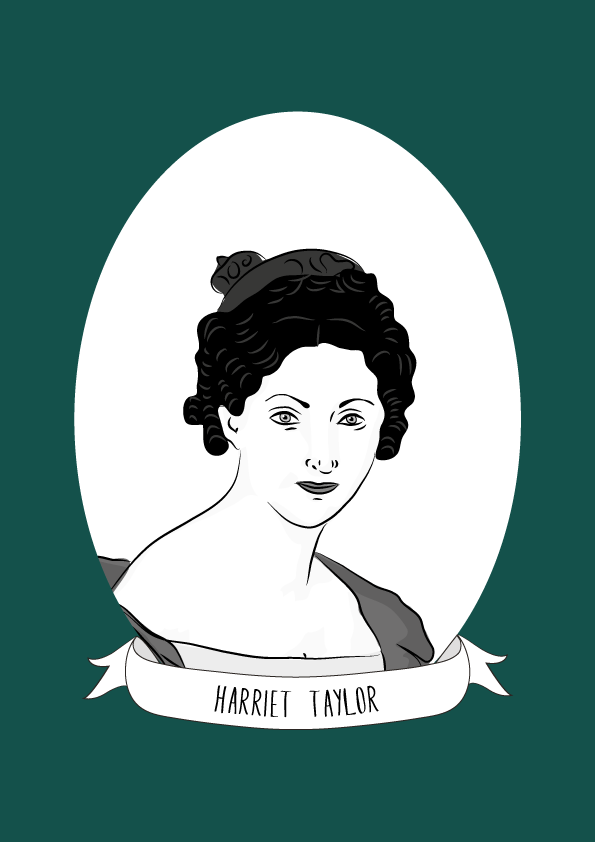Harriet Taylor (also known as Harriet Taylor Mill) was a philosopher and women’s rights advocate.
Taylor was born in 1807 in Walworth, south London to Thomas Hardy, a London surgeon, and his wife Harriet Hurst. She was educated at home, and showed a keen interest in poetry. At the age of 18, Taylor married the 39 year old pharmaceuticals wholesaler John Taylor. The Taylors were active in the Unitarian Church, and developed radical views on politics. They were friends with Reverend William Johnson Fox, a leading Unitarian minister and early supporter of women’s rights. In 1830, Fox introduced Taylor to the philosopher John Stuart Mill, who treated Taylor as his intellectual equal and the two quickly fell in love. They embarked on a scandalous relationship, wherein Mill would make almost nightly visits to the Taylors’ home, visits that John Taylor would facilitate by going to his club. In 1832, Taylor and Mill published “Early Essays on Marriage and Divorce”, which they had written together.
In 1833, after a trial separation of her husband in which she spent
six weeks with Mill in Paris. Taylor moved to a separate residence with her daughter, Helen. Mill began to visit her at weekends, but the two insisted that the relationship was platonic. Despite this,
Taylor and Mill’s relationship lead to them being shunned by society and forced to live in social isolation. Over the next few years, Taylor and Mill exchanged essays on issues such as marriage and women’s rights; the surviving essays reveal that Taylor held more radical views than Mill on these issues. Taylor became interested in the socialist philosophy promoted by Robert Owen in books such as The Formation of Character (1813) and A New View of Society (1814), and many of Taylor’s essays criticised the degrading effect of women’s economic dependence upon men. She felt that this could only be remedied by radical reform of all marriage laws. Mill, like Taylor believed in the importance of equal rights, but favoured laws that would give women equality rather than independence.
In 1848, Mill intended to include details of the role that Taylor had played in the production of his book, The Principles of Political Economy. John Taylor refused to have his wife be named, and all references to her were removed. Later, Mill would write in his autobiography that the book had been a joint effort. In 1849, John Taylor died of cancer. Due to concern about further gossip and scandal, Taylor insisted that Mill wait for two years until they married.
In 1951, a few months after Taylor and Mill’s wedding, the Westminster Review published The Enfranchisement of Women. The essay is considered to be one of Taylor’s most important works, but was published under Mill’s name. It strongly advocated that women should be given equality in all rights, political, civil, and social, with the male citizens of the community. The views expressed within the text were far more radical than Mill’s own. Later that year, an article which advocated new laws to protect women from violent husbands was published in the Morning Chronicle. The article was also wrongly attributed to Mill.
Aside from few articles in the Unitarian journal Monthly Repository, there are very few literary works attributed to Taylor. She was hugely influential in the work of Mill, and in his autobiography he claimed that she was the joint author of most of the books and articles published under his name.
In 1858, Taylor and Mill travelled to Avignon, France to seek treatment for her tuberculosis. While there, she died of respiratory failture. A year later, Mills’ most famous work, ‘On Liberty’, which the couple had written together was published and dedicated to her. Taylor’s daughter, Helen and Mill then worked togethere to develop the ideas that Taylor had outlined in her essay, The Enfranchisement of Women. They developed this into The Subjection of Women, which was published eleven years after her death.
